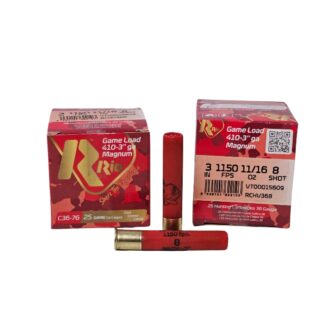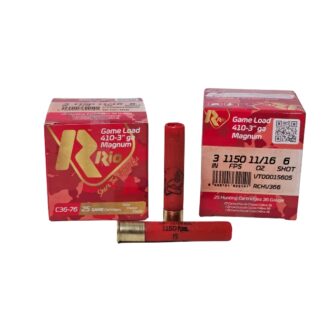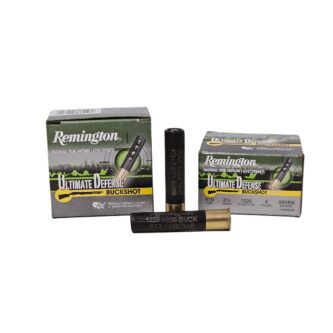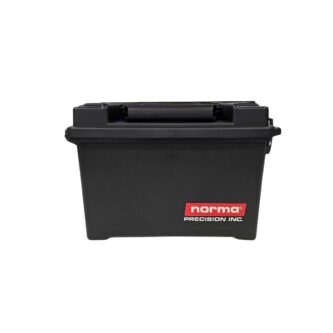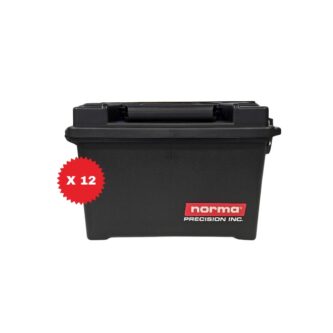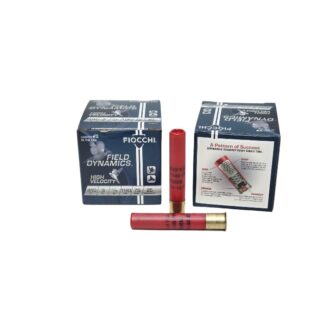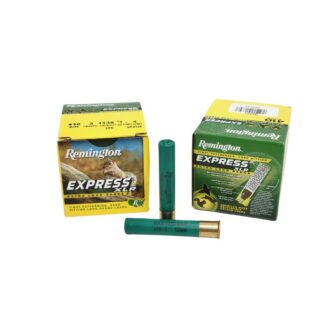The .410 bore holds a unique and intriguing position in the diverse world of shotgunning. Often referred to as the smallest in conventional shotgun sizes, this caliber defies the usual expectations associated with shotgun firepower and versatility. Its diminutive size belies a capability that has garnered it a dedicated following among both novices and seasoned aficionados alike. The .410 bore shotgun is frequently celebrated as an ideal starting point for beginners. Its light recoil and manageable handling make it an excellent choice for introducing new shooters to the sport, allowing them to focus on honing their skills without the intimidation of heavier gauges. Yet, it’s not just a learning tool; for specialists who appreciate the subtleties of shotgunning, the .410 offers a challenging and rewarding experience. Its precision and the skill required to maximize its potential have elevated it to a cult status among certain circles of the shooting community.
Shop .410 Bore at KIRAmmmo.com
From backyard pest control to the refined art of skeet shooting, the .410 bore has proven its worth time and again. As we explore the rich history, development, and characteristics of the .410 bore, we’ll shed light on why this small package continues to make a big impact in the shotgun world.
A Brief History of the .410 Bore
The .410 bore, often mislabeled as a “gauge,” traces its origins back to the early 19th century. Unlike other shotgun gauges, its name reflects the diameter of the bore, which is actually 0.410 inches. The .410 started as a garden gun in Britain and gradually made its way to the United States, where it was first chambered in break-action and single-shot pistols for use in pest control and small game hunting.
The Early Days:
- Initially, the .410 was not even a shotgun shell; it began as a brass-cased cartridge for use in small, versatile firearms.
- It wasn’t long before the .410’s potential was recognized, and it was developed into a shotgun shell, providing a low-recoil option for shooting small game.
Adoption for Various Purposes:
- The .410 gained popularity for its ease of use among youth and beginners, becoming a staple for teaching the fundamentals of shooting and gun safety.
- It also found a niche with experienced hunters who enjoyed the challenge of taking game with the small yet capable bore.
Evolution and Innovation:
- Over the years, the .410 bore has seen various innovations in shell design and loadings. It has been loaded with birdshot, buckshot, and even slugs, expanding its versatility across different forms of hunting and target shooting.
- The advent of modern manufacturing and materials allowed for improvements in the .410’s consistency and performance. High-quality shells and advancements in wad designs have enhanced its effectiveness.
Modern .410 Bore Shotguns:
- Today, the .410 bore is available in a variety of firearm types, from traditional shotguns to modern tactical platforms and even handguns designed for the .410 shell, like the Taurus Judge.
- The .410 bore has also seen a resurgence in popularity as a home defense caliber, with self-defense specific loads offering an alternative to more traditional defense calibers.
The .410 in Sporting Clays:
- In sporting clays, the .410 bore is often seen as the ultimate test of a shooter’s skill, given its small payload and tight patterns. Success with a .410 in competition is a testament to a shooter’s accuracy and precision.
The .410 bore’s journey from a humble garden gun to a respected member of the shotgun family speaks to its adaptability and the affection held for it by those who appreciate its blend of challenge and utility. Its evolution continues to this day, with the .410 finding new roles and enthusiasts in an ever-changing world of shooting sports.
The .410 Bore’s Unique Characteristics
The .410 shotgun shell stands apart in the world of shotgunning due to its distinct physical characteristics. Its design and size have shaped its role in shooting sports and hunting, making it a fascinating subject for those interested in the technical aspects of firearms and ammunition.
Dimensions and Loadings:
- The .410 shell typically comes in lengths of 2.5 inches and 3 inches, with the latter offering increased powder and shot capacity.
- Despite its name, the .410 is actually a caliber rather than a gauge, with the bore diameter being 0.410 inches. In gauge terms, it would equate to approximately 67-68 gauge, if such a gauge existed.
- Common loadings include birdshot with varying shot sizes for small game and clays, buckshot for larger game and self-defense, and slugs for single-projectile applications.
Performance Factors:
- The small diameter of the .410 bore results in a smaller payload and tighter shot pattern. This can be both a benefit and a drawback: it offers less room for error in shot placement but also allows for precision shooting.
- The lighter payload reduces recoil significantly, which is why the .410 is a favorite for young shooters, those sensitive to recoil, and for those who enjoy the challenge of shooting a smaller gauge.
- For hunting, the .410 is best suited to small game and birds at closer ranges. Its performance is maximized when the shooter can get within an optimal range to ensure adequate shot density for a clean harvest.
- In terms of ballistics, the .410’s shot charge travels at a similar velocity to larger gauges, but the smaller amount of shot means energy on target is less. This necessitates careful consideration of the game being hunted and the range of engagement.
Versatility in Ammunition Choices:
- Modern .410 ammunition comes in a variety of choices, catering to different needs. From standard field loads to specialized self-defense rounds and even exotic options like discarding sabots and combination loads, the .410’s versatility is ever-expanding.
- The advent of non-toxic shot and advanced wad designs has also improved the .410’s environmental compatibility and performance, making it a more attractive choice in regions with lead ammunition restrictions.
The unique characteristics of the .410 bore create a shotgun shell that is lightweight, manageable, and precise. These features contribute to its performance in a way that no other shotgun gauge or caliber does, offering a singular experience that’s as rewarding for a seasoned shooter as it is accessible for a beginner. Whether for hunting, sport, or defense, the .410 bore holds a distinct and respected place in the shotgunner’s arsenal.
Comparing the .410 to Other Shotgun Calibers
The .410 bore occupies a unique niche when placed alongside the more widely used shotgun gauges like the 12 gauge and 20 gauge. Understanding how the .410 stacks up against these mainstays can help shooters make informed choices based on their specific needs and scenarios.
12 Gauge vs. .410 Bore:
- Payload and Power: The 12 gauge is known for its versatile power, capable of delivering a wide range of loads from birdshot to slugs. In contrast, the .410 bore’s payload is significantly smaller, which translates to less power and a narrower effective range.
- Recoil and Handling: With greater power comes increased recoil. The 12 gauge is notorious for its kick, which can be challenging for some shooters to manage. The .410 bore offers a stark contrast with its minimal recoil, promoting longer shooting sessions and more comfortable handling, particularly for those with less upper body strength or experience.
- Best Use Scenarios: The 12 gauge is the go-to for most hunting scenarios, from waterfowl to big game, given its power and range. The .410 bore, on the other hand, shines in specialized hunting situations targeting small game and birds, where precision and a lighter touch are required.
20 Gauge vs. .410 Bore:
- Versatility: The 20 gauge strikes a balance between the power of the 12 gauge and the lightness of the .410, offering a versatile option for a wide array of game. It’s often recommended for upland bird hunting where a balance of payload and manageability is key. The .410 bore, while less versatile, is ideal for those wanting a highly skilled hunt with a focus on accuracy.
- Youth and Beginner Shooting: Both the 20 gauge and the .410 are considered excellent choices for youth and new shooters. The 20 gauge offers a step up in power without overwhelming recoil, whereas the .410 provides an even gentler introduction to shooting sports.
- Target Shooting: For clay pigeon shooting, the 20 gauge offers a broader shot pattern, increasing the likelihood of hitting targets. The .410 demands greater precision, making it a favorite among experienced target shooters looking to challenge their skills.
When Might the .410 Be Preferred?
- Training and Skill Development: The .410 is a favorite for teaching the fundamentals of shotgun shooting. Its light recoil and precise shooting requirements help new shooters develop their skills without developing a flinch or other bad habits.
- Specialized Hunting: When hunting small game like squirrels or rabbits, or when bird hunting in close quarters, the .410 allows for a challenging and rewarding experience. It encourages the hunter to get closer to the quarry and ensures minimal meat damage.
- Weight and Portability: The .410’s light weight makes it an excellent choice for long hunts where carrying a heavier shotgun would lead to fatigue. It’s also preferred for its lower noise profile in sensitive shooting environments.
In conclusion, the .410 bore, while not as universally applicable as the 12 or 20 gauges, holds its own in the world of shotguns. Its light recoil, precision, and portability make it a valuable tool in specific scenarios where skill, subtlety, and finesse are paramount.
Versatility in Use: From Pest Control to Clay Pigeons
The .410 bore shotgun, often viewed as a specialist’s or beginner’s tool, actually boasts a wide range of applications, from practical pest control to the competitive arena of clay pigeon shooting. Its versatility is a testament to how this seemingly diminutive caliber can be adapted to various shooting disciplines.
Pest Control:
- The .410 bore is highly effective for controlling small pests and varmints. Its light recoil and adequate power make it ideal for dealing with animals like rodents, snakes, and other small nuisances around farms and gardens.
- The precision required for effectively using a .410 also translates to minimized damage to the surroundings, an important consideration in pest control scenarios.
Upland Game Hunting:
- Among hunting circles, the .410 bore is cherished for upland bird hunting. Targeting species such as quail, grouse, and pheasant with a .410 demands stealth, accuracy, and a close approach, making the hunt a thrilling and skillful endeavor.
- The minimal shot damage to the game is another advantage, particularly for those hunting for table fare. The small shot size and lower shot density help preserve the integrity of the meat.
Competitive Shooting Disciplines:
- In the world of sport shooting, the .410 bore offers a unique challenge. Its small shot charge and tight patterns demand a high level of accuracy and skill, making it a favorite among seasoned clay pigeon shooters.
- The .410 is used in various clay shooting disciplines, including skeet and trap shooting. Excelling in these events with a .410 is often considered a mark of a truly proficient shooter.
Youth and Recreational Shooting:
- For younger shooters and those new to the sport, the .410 provides an excellent platform for learning the basics of shotgun handling and shooting. Its manageable recoil and lighter weight make it less intimidating and more enjoyable for new entrants to the sport.
- Recreational shooters also appreciate the .410 for casual clay shooting and target practice, where its low recoil and precision can turn an ordinary day at the range into a rewarding skill-building session.
The .410 in Specialty Roles:
- Beyond these traditional roles, the .410 bore has found its way into unique applications. In recent years, it has gained popularity in home defense along with the 20 gauge, with specific self-defense loads being developed. Additionally, it’s occasionally used in combination guns and even handgun platforms like the Taurus Judge, further broadening its utility.
In summary, the .410 bore shotgun, with its wide array of applications, stands as a versatile and capable caliber. From the practicality of pest control to the refined skill required in competitive clay pigeon shooting, the .410 offers something for shooters of all levels and interests. Its continued popularity in various shooting disciplines is a testament to its enduring appeal and utility.
The .410 Bore for New Shooters
When it comes to introducing new and young shooters to the world of shotgunning, the .410 bore plays an invaluable role. Its characteristics make it an ideal teaching tool, easing beginners into the sport with a focus on building fundamental skills in a comfortable and confidence-inspiring environment.
Gentle Introduction to Shotgunning:
- The .410 bore is renowned for its gentle recoil, a critical factor for new shooters who may be apprehensive about the kickback associated with larger gauges. This reduced recoil not only helps in maintaining focus on technique but also prevents the development of a flinch reflex, a common issue with heavier recoiling firearms.
- The lightweight nature of most .410 shotguns further contributes to their suitability for young or smaller-framed shooters, ensuring that the firearm is not overly cumbersome or intimidating.
Fostering Shooting Fundamentals:
- The inherent challenge of successfully hitting targets with the .410 bore’s smaller shot charge and tighter patterns encourages new shooters to develop a keen sense of aim, proper gun mount, and shot follow-through. These are essential skills that form the foundation of proficient shotgunning.
- Training with a .410 bore promotes patience and precision. Since the margin for error is smaller, shooters learn the importance of accuracy and careful shot placement early in their shooting journey.
Versatility in Learning Environments:
- The .410 bore’s versatility allows it to be used in a variety of learning environments, from shooting clay pigeons at a range to hunting small game. This flexibility helps keep the learning process dynamic and engaging, catering to the interests of a wide range of new shooters.
- Whether it’s hitting moving targets in a skeet shooting session or aiming at stationary targets for fundamental practice, the .410 bore provides an accommodating platform for diverse training scenarios.
Safety and Confidence:
- Starting with a .410 bore can also instill a strong sense of safety and responsibility in new shooters. Its less intimidating nature allows instructors to effectively communicate safe gun handling practices and the importance of responsible shooting.
- The satisfaction and confidence gained from mastering a .410 shotgun can be a significant factor in encouraging continued participation and growth in the sport.
In conclusion, the .410 bore shotgun serves as an excellent introductory tool for new and young shooters. Its gentle recoil, the requirement for precision, and its adaptability as a training tool help in building solid shooting fundamentals, fostering a safe and enjoyable learning environment. For many, the .410 bore is the first step in a lifelong journey of shooting sports and outdoor adventure.
Technical Talk: Chokes and Patterns
Understanding the technical aspects of the .410 bore, particularly regarding chokes and shot patterns, is crucial for shooters to optimize their experience with this unique caliber. The .410’s small size and tight patterns require a more technical approach to get the most out of each shot, especially in different shooting scenarios.
Understanding Chokes in the .410 Bore:
- Choke Basics: Chokes constrict the end of the shotgun barrel, controlling the spread of the shot as it exits the firearm. The degree of constriction influences the density and size of the shot pattern at various distances.
- Impact on the .410: Given the smaller payload of the .410 bore, the choice of choke can significantly impact its effectiveness. The right choke can transform a .410 bore shotgun from a close-range specialist to a more versatile tool.
Types of Chokes for the .410 Bore:
- Full Choke: Ideal for long-range shooting, a full choke keeps the pattern tightest over distance, which is beneficial for small game hunting or clay pigeon shooting where precision is key.
- Modified Choke: A compromise between spread and range, the modified choke is versatile for medium-range shooting and is often preferred in upland bird hunting.
- Improved Cylinder and Cylinder Chokes: These chokes offer a wider spread and are suited for close-range shooting, making them a good choice for beginners or for hunting in dense cover.
Optimizing .410 Performance with Chokes:
- Matching Choke to Activity: Shooters should select a choke based on their specific activity. For instance, skeet shooting often calls for an open choke like an improved cylinder, while hunting small, fast-moving game might benefit from a tighter pattern provided by a modified or full choke.
- Pattern Testing: It’s advisable for shooters to pattern test their .410 bore shotguns with different chokes and ammunition types. This involves shooting at a pattern board at varying distances to visually assess how different chokes affect shot spread.
- Adjusting to Conditions: In the field or at the range, shooters might need to adjust their choke selection based on specific conditions, such as target distance, wind, and the type of game being hunted.
Chokes as a Tool for Skill Development:
- For the seasoned shooter, experimenting with different chokes in a .410 bore can refine skills such as judging distance and shot placement. It encourages a deeper understanding of the relationship between the shooter, the shotgun, and the target.
In summary, chokes play a significant role in the performance of a .410 bore shotgun, affecting its versatility and effectiveness in various shooting disciplines. By understanding and utilizing different chokes, shooters can significantly enhance their shooting experience, making the .410 bore a more adaptable and precise tool for their shooting needs.
The .410 in Modern Times
In recent years, the .410 bore has seen a resurgence, not only in traditional shotgun circles but also through innovative adaptations in firearms technology. These modern developments have not only sustained the .410’s relevance but have expanded its appeal and functionality.
Innovations in Shotgun Design:
- Modern manufacturing techniques have led to the creation of more efficient and reliable .410 shotguns. These range from improved over-and-under and semi-automatic models to ultra-light and compact designs, catering to both the sporting and tactical markets.
- Innovations in barrel technology, such as screw-in chokes and ported barrels, have enhanced the performance of .410 shotguns, making them more versatile and user-friendly.
.410 Ammunition Advancements:
- The .410 bore has benefitted from advancements in ammunition technology, including better-quality shot, more consistent powders, and improved wad designs. These improvements have enhanced the .410’s performance in terms of pattern consistency and shot effectiveness.
- Specialty ammunition, such as self-defense rounds with increased stopping power and less risk of over-penetration, has made the .410 a more viable option for personal protection.
Development of New .410 Firearms:
- A significant trend has been the introduction of firearms chambered in .410 but not traditionally classified as shotguns. For example, the Taurus Judge and the Smith & Wesson Governor are revolvers that can fire both .45 Colt cartridges and .410 shotgun shells, offering versatility and increased firepower for self-defense.
- Similarly, there has been a rise in rifles chambered for the .410 shell, including lever-action and bolt-action models. These firearms are particularly appealing for small game hunting and pest control, offering precision and ease of use.
The .410 for Home Defense:
- The .410 bore has gained traction in the home defense market. Its low recoil and adequate stopping power, especially with defensive loads, make it an attractive choice for those seeking a less intimidating but effective home defense tool.
- Manufacturers have responded to this demand with .410 shotguns designed specifically for home defense, featuring shorter barrels, larger magazine capacities, and ergonomic designs for quick and easy handling.
The .410 in Competitive Shooting:
- In the realm of competitive shooting, the .410 bore continues to be a standard in disciplines like skeet, where it provides a challenging but rewarding experience. Its use in competition pushes the boundaries of what can be achieved with this small caliber, showcasing its potential in the hands of skilled shooters.
In the modern era, the .410 bore has transcended its traditional roles, embracing innovation and versatility. From revolvers and rifles to advanced shotguns and specialized ammunition, the .410 continues to adapt, proving its enduring value and appeal in the diverse world of shooting sports and personal defense.
.410 Bore Myths vs. Facts
Despite its long history and unique niche in the world of firearms, there are several myths and misconceptions surrounding the .410 bore. It’s essential to separate fact from fiction to understand the true capabilities and limitations of this caliber.
Myth 1: The .410 is Only for Beginners
- Fact: While the .410 bore is indeed an excellent choice for beginners due to its low recoil and ease of handling, it’s not solely a beginner’s gun. In the hands of an experienced shooter, the .410 can be a challenging and rewarding tool for hunting and sport shooting.
Myth 2: The .410 Lacks Stopping Power
- Fact: The stopping power of any firearm is contingent on factors like shot placement, load, and distance. While the .410 bore has a smaller payload compared to larger gauges, modern defensive loads have enhanced its effectiveness, making it a viable option for self-defense, especially at close ranges.
Myth 3: The .410 is Ineffective for Hunting
- Fact: The .410 bore can be highly effective for hunting, particularly for small game and birds. Its effectiveness lies in the shooter’s ability to get closer to the target and make precise shots. With the right ammunition and within its optimal range, the .410 can successfully take down game.
Myth 4: .410 Ammo is Hard to Find
- Fact: While .410 ammunition was once less commonly available than other shotgun shells, it’s now widely produced and stocked by many manufacturers and retailers. The growing popularity of the .410 has ensured a steady supply of various ammunition types.
Myth 5: The .410 is Not Suitable for Home Defense
- Fact: Although not as powerful as larger gauges, the .410 can be used for home defense, especially with ammunition designed for this purpose. Its lower risk of over-penetration and lighter recoil make it a choice worth considering for certain home defense scenarios.
Myth 6: The .410 is Less Accurate Than Larger Gauges
- Fact: The accuracy of a shotgun is more a function of the shooter and the gun’s fit and design than the gauge itself. The .410’s tight pattern can actually offer greater precision, which is why it’s favored in sports like skeet shooting.
In debunking these myths, it’s clear that the .410 bore is a versatile and capable caliber when used within its intended roles. Its unique characteristics offer distinct advantages and challenges, making it a valuable addition to the arsenal of both novice and experienced shooters alike.
Conclusion
The journey of the .410 bore through shotgun history is a narrative of adaptability, innovation, and enduring appeal. From its humble beginnings as a garden gun to its current status as a versatile tool for both beginners and experts, the .410 bore has carved out a unique niche in the world of firearms. Its distinct characteristics, such as the minimal recoil, precise shot patterns, and lightweight nature, have not only made it a favorite for teaching new shooters but also a challenging option for skilled marksmen in hunting and competitive shooting.
The .410’s evolution over time, especially with the advent of modern shotgun designs and varied ammunition offerings, has expanded its utility beyond traditional uses. Today, it finds applications in everything from small game hunting and pest control to clay shooting and even home defense. This versatility is a testament to the .410 bore’s ability to adapt to the changing needs and preferences of shooters.
Understanding the .410 bore’s capabilities and limitations is crucial for its effective and enjoyable use. Its role as a teaching tool emphasizes the importance of starting new shooters off right, focusing on fundamentals without overwhelming recoil. For the experienced shooter, the .410 bore offers a test of precision and skill, particularly in scenarios where shot placement is paramount.
The .410 bore’s enduring presence in the shooting world is a reminder of the importance of matching a firearm’s characteristics to its intended use. Whether it’s for the novice learning the ropes or the veteran seeking a new challenge, the .410 bore continues to offer a unique and fulfilling shooting experience. Its place in shotgun history is not just a matter of tradition but a continuing story of versatility, challenge, and innovation.
Shop KIR Ammo for your .410 Ammunition:
At KIR Ammo, we invite you, our readers, to join the conversation. Whether you’re a seasoned .410 enthusiast or a newcomer intrigued by its unique qualities, your experiences and insights are invaluable.
- Share Your .410 Stories: Have you had memorable outings with a .410 bore shotgun? Perhaps a first hunting trip, a successful day at the skeet range, or even a personal defense scenario where the .410 played a role. We’d love to hear your stories and experiences. Your journey with the .410 bore can inspire and educate others in our community.
- Ask Questions and Engage: If you’re considering adding a .410 bore to your collection or have questions about its suitability for your shooting needs, don’t hesitate to reach out. Engage with us and fellow enthusiasts on our social media pages. Let’s deepen our understanding of this versatile gauge together.
- Discover the .410 with KIR: At KIR Ammo, we’re committed to delivering not just ammunition, but a superior shooting experience. We understand the importance of quality, which is why we offer a wide range of .410 ammunition from a variety of premium ammo brands, catering to all your shooting needs. Whether it’s for hunting, target shooting, or self-defense, we have you covered.
- Experience Our Service: We pride ourselves on our quality customer service, ultra-fast order processing, and great prices on bulk ammunition. Our dedication to your satisfaction makes KIR Ammo your go-to source for all your ammunition needs.
The .410 bore is more than just a caliber; it’s a gateway to a diverse and rewarding world of shooting sports. Explore its possibilities, share your experiences, and join our community of enthusiasts. Remember, whether you’re a beginner or a pro, the right gear and the right advice make all the difference. Check out our selection of .410 ammo and let us help you make your next shooting experience, a memorable one.
